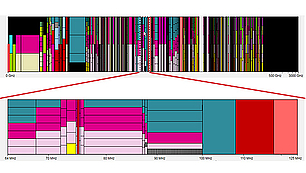Management of Frequency Plans
Before frequencies can be assigned to dedicated stations at specific locations, first the rules for distribution have to be defined. For that purpose our module SPECTRAplan can be used. It includes the frequency allocation tables from the ITU for the relevant region. Those frequency allocation tables can be adapted to comply with local specifics and equipped with channel allocations for dedicated use. Besides that, new frequency plans can also be created completely from scratch. By this means, SPECTRAplan is able to store and maintain both national and international frequency allocation plans in parallel. With SPECTRAplan you can stay up to date when new ITU plans are published and ensure that the national frequency plan is compliant with the ITU regulations. A seamless integration with mySPECTRAoffice and SPECTRAemc allows you to access the respective information during licensing and during frequency assignments in a convenient way.
Key Features of SPECTRAplan
Discover how our frequency plan management software enhances regulatory efficiency and accuracy.

Frequency Table Management
Create and manage national and international frequency allocation tables to build a solid basis for your licensing procedures.

Interactive Allocation Charts
Visually explore and drill down everything from frequency plans and allocations to channel-specific information using dynamic, zoomable diagrams.

Channel Raster & Duplex Planning
Use automated tools to configure duplex or simplex channels based on frequency bands, bandwidths, and spacing.

Regional Allotment & Vector Mapping
Assign channels to specific regions and visualize constraints using vector data on the integrated geographical information system (GIS).